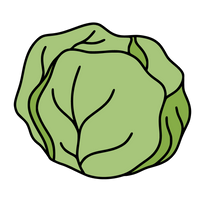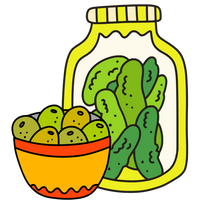
The two top questions about the timing of eating ferments are:
"When is the best time to eat sauerkraut for gut health?" (or pickles, or kimchi).
And "How often should you eat fermented foods for gut health?"
In this article we'll answer these questions, giving you the when, the how and also the why.
Let's get started first by covering the two basic principles for eating these live culture, raw, probiotic foods for a healthy gut.

Principal #1: CONSISTENCY
Consistent, daily introduction of outside probiotic foods to your inside, 'resident' microbiome is the key.
By stimulating the gut microbiome on a regular basis, you compound the benefit of this activity over time and build your strongest gut.
Why?
First, fermented vegetables contain prebiotic, insoluble fiber that the bacteria in your gut feed on. Eating fiber rich foods like fermented pickles is the best way to nourish and strengthen your microbiome.
Second, ferments like sauerkraut and kimchi contains lactic acid bacteria, living microorganisms that grow and flourish during the fermentation process. These beneficial bacteria interact with and stimulate the flora in your gut, boosting the immune system. (1)
So by eating ferments you get the health benefits of both the prebiotics and probiotics from a natural, whole food source.
How much sauerkraut should I eat? (or pickles, or kimchi)
Eat a serving size three times a day which can get you to the consistency you need to achieve the gut health benefits of fermented foods.
How much sauerkraut is too much? (or olives, or brine)
Some of our customers LOVE to eat much more than three serving sizes a day and ask whether it’s possible to eat too much. If your body can handle more ferments, then we say ENJOY! Ferments are alive, life-giving foods and there are no adverse effects to enjoying them in abundance.
If you're just getting started, your individual tolerance for ferments will depend on the current state of your gut and how accustomed you are to eating them.
Not sure where to start? Begin with one serving per day and work your way up. Your body will tell you to back off if you overdo it. Your tolerance for more ferments will grow with time.

Principal #2: BIODIVERSITY
Each different kind of fermented vegetable has a unique microbial composition. Your microbiome thrives on exposure a biodiversity of beneficial bacteria.
When you introduce a variety of fermented vegetables and mix it up, it's also a more interesting way to eat. That means you'll be more inclined to stick with your new healthy habit.
To succeed and have fun, you need choices and options. When it comes to having a biodiverse variety of ferments you need, Olive My Pickle has you covered. Our community of customers are pursuing fermented food as a lifelong habit, not a fad or a phase, and we are here to support that!
To get to know our six categories of ferments and the many choices available to you, please keep reading the second portion of this article.
The optimal time to eat sauerkraut, kimchi, fermented pickles, and WHY
Optimally timing your consumption of ferments means understanding enzymes. Importantly, probiotic food ferments are rich in food enzymes. Why does this matter?
70% of your body's energy goes toward digesting food. To create that energy, your body must create and use digestive enzymes.
Digestive enzymes are expensive. Each of us is born with a "bank" of enzymes, (also known as our enzyme potential), and we use this throughout our life.
Because enzymes are the biological catalysts by which all mechanisms occur within the body, when you run out of enzymes, death occurs.
An abundance of research has shown that enzyme depletion and aging go hand in hand. In fact, enzyme measurements in young adults is researched to be 30 times stronger than those in adults over the age of 69. (2)
All cooked foods are 100% depleted of food enzymes, they are killed in the heating process. The same goes for processed food which is factory pasteurized, denatured. Both cooked and processed foods are very expensive to our bank of enzymes!
Knowing this, it makes a lot sense to make frequent "bank deposits" of enzymes, by supplementing.
How to do this is quite easy: simply eat enzyme-rich foods with every meal.
What are the foods that are the most enzyme-rich? Those would be fermented and probiotic foods such as pickles, sauerkraut, kimchi, olives and brine.
Other excellent sources of enzyme rich foods are raw fruits and vegetables, raw milk, raw cheese and raw kefir. How about kombucha? Drink it as a rare treat: its trace alcohol levels and sugar content may undermine the gut health benefits you are seeking from its probiotics. Kombucha is also high in yeast and consuming too much can create yeast overgrowth.
The best way to aid your body, stretch your enzyme potential and literally lengthen your life is to eat enzyme rich foods whenever you're eating anything cooked.
As far as timing? It's most optimal to eat enzyme rich fermented food at the beginning of the meal, so they can begin the work of helping digestion as soon as they land in the stomach.

To summarize, remember these 3 basics:
-
Eat ferments consistently, three times a day as a lifestyle approach over the course of your life.
-
Eat a biodiversity of fermented and probiotic foods.
-
Time your consumption to the beginning of any meal that has cooked foods to conserve your enzyme potential and lengthen your life.
This should answer your question about how much sauerkraut, (aka fermented cabbage) to eat, when to eat it and why.
Learn more about the different varieties of ferments we sell here at Olive My Pickle: keep reading!

Pickles
Cucumber pickles are a classic favorite. Our Kosher Dill is the #1 most popular, followed closely by The Garlic Pickles. You really can't go wrong with any of our varieties and we have some stronger flavors, including The Onion, Spicy Dill and Horseradish Pickles.
The #1 question we get is, how does the taste of fermented pickles compare to vinegar pickles?
Fermented pickles are flavorful and delicious, but they are less acidic than vinegar pickles, so they lack that "punch you in the face" affect. They are flavored with salt water and the actual fermentation process which creates a sour, umami flavor.
Many customers who eat their first fermented pickle don't believe us when we tell them there's no vinegar, that's how flavor packed a fermented pickle can be.
The #2 question is, yes but are they crunchy? The answer is yes, they are crunchy and they derive this from the appropriate amount of salt in the brine. (A soggy fermented pickle is one where not enough salinity was achieved in the ferment.)

The Truth About Sauerkraut
Did you know? Sauerkraut is the most versatile of all ferments and the healthy benefits of sauerkraut are numerous.
Many people new to ferments think that sauerkraut only belongs on ‘brats and dogs,' but the truth is that sauerkraut is the probably easiest of all fermented foods to work into your daily diet.
Sauerkraut goes with eggs in the morning, into your salad or in your sandwich at lunch and is the perfect side garnish on any dinner plate. Since you now know how much sauerkraut to eat, you can sneak a forkful anytime to satisfy your sour and salty cravings.
Our Best Sauerkraut Bundle is the easy button if you're looking for a variety of proven best sellers. If you're already eating sauerkraut or are sauerkraut-curious and want to start small, opt for the Carrot + Dill Sauerkraut, its slightly sweet and mild flavor makes it a perfect beginner's sauerkraut and its our #1 selling sauerkraut.

Getting Real About Kimchi
Kimchi is often what people associate with fermented foods.
What is Kimchi? It's spicy fermented cabbage, made in the Korean tradition. Traditional Korean Kimchi may contain some kind of fish element– either sauce or oil, which makes it some funky, fragrant stuff!
Traditional recipes can also carry a very high heat level. Our kimchi varieties at Olive My Pickle do not contain any fish elements (our entire product line is vegan friendly.) As far as heat level, while our kimchi are spicy, we describe their levels as ‘pleasantly warm.'
If you're brand new to ferments and looking to get started, we recommend opting for sauerkraut first and then moving into kimchi as a phase 2 item. But if you're ready to try, give our Classic Kimchi a go and never look back.

Yes, Olives are Probiotic
Olives are probiotic but you have to look for them. They must not contain vinegar and not be pasteurized. (That means any olive sitting on the dry shelves at the supermarket are NOT probiotic.)
Our olives at Olive My Pickle are probiotic, brined in salt water and never pasteurized. Beyond their live culture status there are so many more great things about olives that we wrote about in 10 Benefits of Eating Healthy Olives.
With over a dozen varieties to choose from, get started the easy way with our Healthy Olive Bundle. If you want to start simple, go with the Butter Olives, the top selling favorite.

Probiotic Brine
You've heard us say to eat ferments three times a day, as snacks or with meals.
Doing a LiveBrine shot is a fast and easy way to help get that done. There are 14 billion CFUs of lactobacillus in a two ounce serving– that's the size of a standard 1.5 ounce shot glass.
We make 8 varieties of LiveBrine, each with a distinct flavor, color, health benefits and superfood profile. To make your life easier, we created the LiveBrine Buying Guide, which explains in details the special characteristics of each variety.
Head over to our LiveBrine page to discover the many ways to incorporate this probiotic elixir into your day.

Veggies
You can ferment anything. We've tried just about every vegetable you can think of and our lineup of fermented veggies is the best of the best.
Our Veggie Medley is a chunky mix of green fermented cabbage, carrots, cauliflower and red bell peppers. Also known as giardiniera, this is a delicious and flavorful mix. Try our Okra, Spicy Green Beans and Fermented California Garlic.
Sources:
You have a favorite ferment waiting to be discovered.
If you're looking for the easiest path forward try either our Ultimate Gut Health Bundle or our Best of Olive My Pickle Bundle below.








